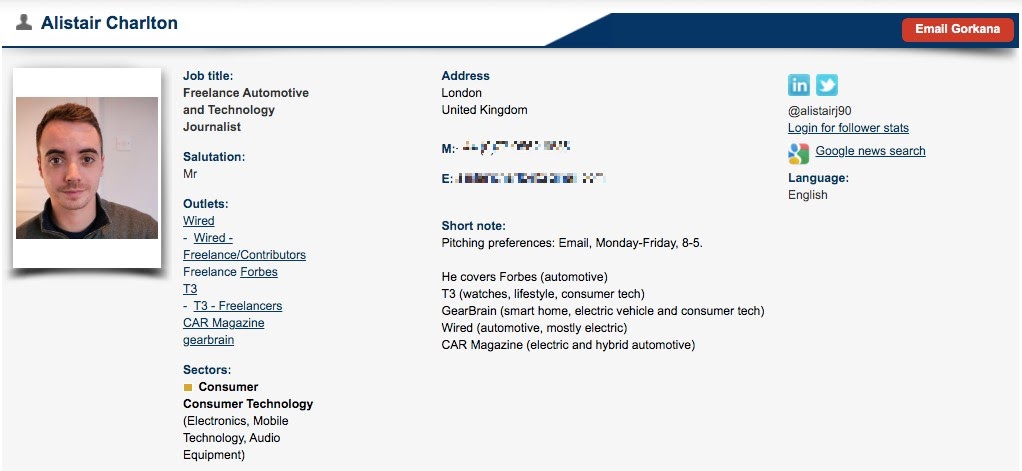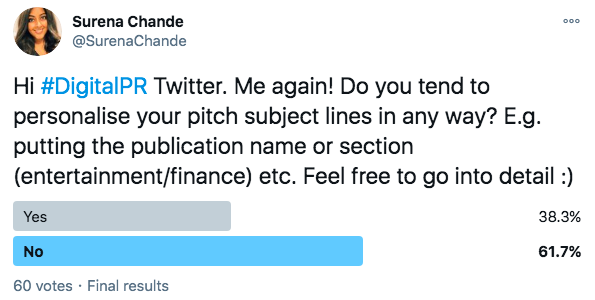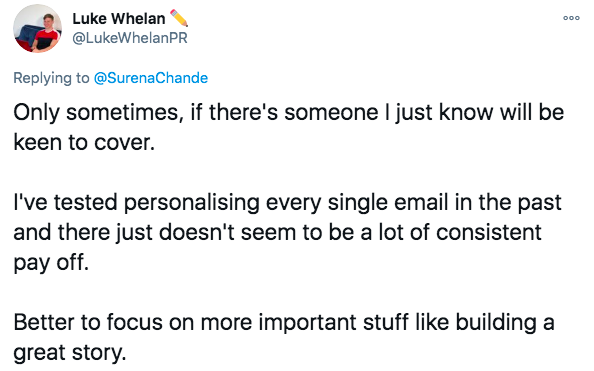Table of Contents
They may comprise a mere 9 to 13 words (which is the optimal length according to our recent subject line study), but these words hold plenty of power. As one of the only chances you have of getting your campaign seen by a journalist, subject lines are arguably the most important part of your media pitch.
As a journalist, I’ve seen and deleted thousands of PR emails over the years. Many were trashed after reading just the subject line, others, after reading the introduction. I’ve encountered good, bad and outright awful attempts.

As a Digital PR, I’ve probably produced all of the above.
However, after four years in the industry and eight as a journalist and writer, I’d like to believe that I understand what makes a ‘good’ subject line.
While there isn’t a one-size-fits-all approach, given the diversity of campaigns, multiple factors go into making your subject line interesting and enticing to journalists. Some aspects will make them more likely to succeed.
So, from relevancy and clarity to reframing your statistics and making them a little sexier, I’m going to talk you through: my dos and don’ts, what journalists have to say about subject lines, and some of the tips and tricks from others in the industry.
Relevancy
We’ll start with the most important aspect, which is crucial to your pitch standing a chance of getting picked up.
In Cision’s State of The Media Report 2020, it found that a mere 1% of journalists surveyed said that they ‘consider 75%-100% of the pitches they receive as relevant’.
This is commonly found among journalists I spoke to for this piece. When asked what percentage of pitches she receives are irrelevant, Freelance journalist Ella Delancey Jones reveals, “I would say a large majority, around 80-85%, are not relevant. Sometimes it’s that I’ve slipped onto a media list and am receiving all releases from an agency, but other times it’s when a PR knows I wrote about X once so I must always write about X.”
Another Editor for the Lifestyle Section of a top-tier publication (who requested not to be named) explained, “About 80%, most of them aren’t relevant – sometimes it’s because they aren’t topics we cover and other times it’s because the idea is too general (we’ve done it before), or it’s not new.”
Additionally, when asked what PRs could do to help, the majority (37%) of journalists participating in the Cision survey believed that they should “understand my target audience, and what they find relevant.”
How to target correctly
When preparing an angle for a campaign, thorough prospecting is essential. This doesn’t mean gathering a list of Lifestyle writers from Gorkana and hoping for the best. This is commonly known as the ‘spray and pray’ approach.
Rather, narrowing down a group of writers in a sector and ensuring their recent pieces reflect what you’re pitching them – whether you use Twitter, Muck Rack, LinkedIn or other means to do so, this is a vital step.
Without thorough prospecting and targeting, you could have the best subject line and the correct publication, but the completely wrong author or sector. And, as I have said many times, journalists often lack the time needed to pass on every misdirected pitch to the correct colleague/desk.
It’s also crucial to understand sectors when pitching pieces. For example, I was an Online Showbiz News Reporter at OK!.
I received many pitches about celebrity lifestyle stories such as new clothing line launches or collaborations. You’d think pitches about anything celebrity-related would be relevant to me, but this assumption is completely wrong.
I covered Showbiz news, which entailed covering any breaking celebrity stories from social media or sources (such as cheating scandals, breakups, pregnancies etc.).

Therefore, unless a PR was getting in touch with me about a celebrity interview or exclusive, most pitches were completely irrelevant.
One of the most failsafe ways to combat misguided pitches is by reading through an author’s recent articles to understand the type of content they may be looking for.
With freelancers, this is a little more tricky because we are often freelancing for a range of publications and writing about a variety of topics.
Many will often have pitching guidelines in their Twitter bios or Gorkana notes, so it’s worth checking those first to avoid wasting their time and yours.

However, don’t be afraid to pitch freelancers, as your pitches can sometimes spark ideas for us when writing features. We may be able to refer to your data or utilise your client for an interview when writing the piece, both of which often result in links, too!
Personalisation
Once you’ve got the relevant prospects narrowed down, look through the headlines surrounding your target topic and sector to ensure your subject line is formatted to suit them.
I have never personalised every single subject line to the journalist and publication, however, my angles are personalised to a degree.
By this, I mean I keep the target sector in mind and what their readers would be likely to click on when formulating headlines.
Journalists are often aware that they are part of a larger outreach list, but if a story is good enough they are usually happy to cover it.
There are ways to personalise by sector, which I outline below, but I wanted to highlight there is no right or wrong answer as both work from my experience and that of others that I have spoken to.
I conducted a Twitter poll to see whether Digital PRs personalise pitch subject lines in any way.

While the majority of respondents (61.7%) said they did not, it sparked an interesting discussion, from which I learnt some great tips from.
Freelance Digital PR Luke Whelan takes a similar approach to me.

Though, we both always ensure that subject lines are altered depending on the hooks and angles. We also change the content of subject lines for various data points that different ‘groups’ of prospects will be interested in.
On the other hand, Freelance Digital PR Consultant and travel blogger Chris Nunn, explains, “I’ll often put something like ‘Story tip for xx:’ or similar. It’s half to tell them it’s a pitch and so it doesn’t look as spray and pray. Mixed bag results-wise but I like to use it to help my own tracking and, I’d like to think, it makes it more personable.”
Becca Peel, PR Account Manager at Tank PR, takes a similar approach with exclusives. She says, “If I’m offering an exclusive, I’ll put ‘exclusive for xxx’ in the subject line and most of the time get a response that way!”.
So, I asked the journalists I spoke to for this piece what they thought about personalisation.
What journalists want
In general, my subject lines are fairly indicative of the type of content I am pitching to a journalist.
For example, if I were to pitch a story with a subject line such as, ‘(Data) Speeding study reveals Kent is the worst UK hotspot’, to News Editors at regional publications, automotive sections of publications and nationals, it leaves no room for confusion at what the story is about.
However, when it comes to more traditional PR outreach or if you feel it could help your pitch, Ella Delancey Jones suggests, “If someone is a beauty journalist, it’s about making it obvious in the subject line: NEW BEAUTY PRODUCT, for example. A keyword that relates to the journalist’s field can really draw the eye.”
Freelance Beauty and Lifestyle Writer Vanese Maddix echoes this and says she appreciates when her niches are highlighted in the subject line.
This is also preferred by the Lifestyle Editor I spoke to, who explains, “I like when they include buzzwords in the subject line, too. We cover mental health/green living/wellbeing/food a lot, so I’d suggest something like ‘FOOD PITCH: XXX’ so that I know it’s on a topic we’d cover!”
Their advice has made me rethink my tactics because, despite the story being clear, an extra nudge in the subject line (to simplify their inbox reviewing process) in the form of a sector keyword could potentially boost my chances of outreach success.
If you haven’t tried it, this is something that could be worth attempting in your A/B testing when outreaching.
BuzzStream makes this extremely easy, given the ability to be organised with your client and campaign folders. See more about it in our media pitch post.
However, to summarise:
- Within your campaign folder head to ‘Sequences.

- Click on the templates tab and create two templates with two different subject lines. The content of the body copy can be the same.

- Outreach both to two different equally-sized sets of prospects. After a few hours, begin reviewing the open rate success.
If there’s little to no difference, continue outreaching the subject line you prefer to the rest of your prospects for that angle. However, if there’s a vast difference it’s time to…

Personalisation by sector
In addition to highlighting the topic keyword, it’s also important to ensure the rest of the language in your subject line is relevant to the sector.
Do this by searching your topic keywords on Google News, as well as visiting the sectors on multiple publications e.g. Automotive, Entertainment, Travel etc.
Inspect how their headlines are written in terms of:
- The language and tone of voice
- The way they format the copy
- How they frame the most interesting part of the story and statistics.



The Google News example above shows exactly how reporters from each publication have framed the same story for their audiences.
Researching your topics in this manner can take minutes, but will provide you with plenty of inspiration when it comes to writing your own.
It’s insightful to see what each writer omits and includes, to inform their readers of the key angle, it’s also interesting to see the simplicity of the language used and this can be a lesson in how to de-fluff your subject lines.
This brings me to my next point, which is the main aspect journalists look for in a subject line…
Clarity
In the headline screenshots, notice the directness and lack of unnecessary detail in the headlines.

While we all try to convey the intrigue of a story in subject lines, it can be worth noting that simplicity is often key to enticing a journalist to open your pitch.
“Waffley pitches get binned very quickly; this includes giving a lengthy introduction to the brand (a line will suffice)… A common mistake many PRs make when starting out in the industry is starting emails with, “Hi [name], I love the article you wrote recently about X so I thought I’d send you this study we went on X.”
We know which articles we have written, and, while it’s nice to know that you’ve enjoyed our work, we have limited time and lots of emails to get through (many receive over 100 press releases daily).
Don’t make us dig for a story. Get to the point quickly and make your story clear from the subject line down to the introduction and body copy.
Cut the clickbait
The main tip I would advise Digital PRs to follow is to avoid writing clickbait subject lines no matter how tempting it may be.
It’s part of a journalist’s job to write enticing headlines to draw in readers. However, if you try to do the same you could either put a journalist off or miss out on crucial information about the ‘thing’ you are pitching that would’ve led to them opening your pitch.
For example, if you have a UK study on the worst towns and cities for speeding, don’t leave the Editor or Reporter you’re pitching to guessing which town or city the worst offender may be.
Note: the study and statistics in these examples are completely fictional.

The example above is full of waffle in the subject line.
Firstly, though you may think a ‘shocking study’ may entice a journalist into opening your email. However, this is unlikely in reality and will only annoy the prospect. They have seconds to scan their inbox for stories, and if they don’t see one emerging from your subject line, you’ve missed your shot.
The purpose of the study also isn’t revealed until the very end, which means your targeting for the pitch may have been great but you’ve probably lost their interest by the fifth word.
And finally, the ‘worst’ town or city isn’t revealed at all, so they have no idea if it’s relevant or interesting e.g. if London’s revealed to be the worst city for speeding in the UK, it’s not likely to be as newsworthy as somewhere more obscure.
3 steps to structuring a solid subject line
Though they’re only a handful of words long, there is a lot that goes into a subject line, and I hope the points above have given you an understanding of what to include and avoid, and why.
In the example above, I showed you how not to format a subject line. Below, is what I would amend this with.

And I’m now going to take you through the three steps I try to follow when constructing subject lines:
1. Inform the journalist of what sort of information they are receiving
This was a great tip I learnt from a former colleague. While a strong subject line doesn’t necessarily need it, including something along the lines of (Data) can help strengthen your chances of success.
For example, top-tier and regional publications tend to prefer data-backed studies and stories, so clarifying it in the subject line rather than merely stating ‘Study finds X’ is useful.
This can be interchanged with the following, depending on your campaign:
- Illustrations
- Video
- Game
- Quiz
- Gallery
- Products
- Competition
- Expert (for emails like 8 tips for X)
For the same reasons mentioned above, a journalist appreciates as much clarity and signposting as possible with emails.
If they’re quickly taking a break to scroll through 100+ emails and yours includes keywords and what content they expect, it can significantly improve your chances of an open and consideration.
Try to make this clear beyond the bracketed pointer, too. For example, instead of saying ‘Vet shares pet lockdown socialisation tips’, clarify how many tips the journalist is getting and weave it in.
You’ll end up with something like ‘(Expert) Vet’s 8 tips for pet lockdown socialisation’. It’s short, to-the-point and the journalist can immediately decide if it can help with/inspire an article.
2. Identify the story
I was previously hellbent on writing my pitch subject line before I wrote any of the body copy. However, over time, I have learnt that it’s the very last thing I should write in a pitch as you get to know your own story far better once you’ve written the entire pitch surrounding it.
This advice sounds obvious, but sometimes you can get so caught up in your campaigns or perceived ideas of a piece, that you completely miss the strongest stories.
An example that stands out is from a speeding campaign I worked on.
We had data on the fastest speeds recorded in certain towns/constabularies, as well as the most active speed camera locations.
To begin with, I thought the highest recorded speeds would be a shocking stat to go to publications with.
Yet, you have to consider the audience reaction element. A person is more likely to tag their friends and family in the Facebook comments of a story about a speed camera in their town being the most ‘active’, as opposed to their town having one person who was speeding the fastest.
Always put yourself in the position of a reader, as audience views are what journalists are measured on, and you’re likely to see success.


Another example is a campaign about running that I was put on last year.
I thought a release surrounding the UK regions that run the most and least would be an undoubted success. Everyone likes a bit of competition, right? However, after one round of outreach, I found that it had almost no interest and I quickly realised that I was focusing on the least-strong elements of the study.
I believe this was partially due to the study focusing on UK regions. This can work for nationals if the story is strong enough. However, local publications tend to prefer granular data breakdowns featuring towns, cities or boroughs. And this was data we had not acquired, so I knew I needed to try another approach.
Fortunately, the study’s survey had included a question about the reasons behind why Brits were running and one of the answers was related to people running for their mental health.
I began outreaching this piece at the beginning of the pandemic when lockdown had been announced and people were trying to find ways to cope, and soon realised this would be the perfect angle to go out with.
It immediately saw success.

Though, I’d initially been too blind to see it because I was so caught up in the piece supposedly being more to do with the running abilities and preferences (times of day, how long for etc.).
Therefore, I’d suggest taking time to look through your pitch and the campaign, as a whole, again before writing your subject line. Try to look at it with an open mind and see what other sectors it could appeal to, or which angles it has that could actually be far stronger.
If your campaign is data-heavy, you’ll be familiar with copying in the strongest stats and tables from the piece. You also generally have an idea of the angle and key stat you’re pinning the outreach on.
Once you’ve finished your pitch, have another look through each of those and see if you could have missed another crucial angle.
It often helps to ask colleagues who have not worked on the campaigns to look over your templates, too, as they’ll sometimes spot stand-out elements that could make for great subject lines.
3. Spruce up your statistics
This is an area I initially struggled with. I went into writing for a reason – numbers and data are often my nemeses.
However, after multiple people at Verve Search going through framing statistics with me and several years of experience, I’ve finally got the hang of it!
I was previously guilty of using percentages to enforce a point e.g. ‘40% of Brits do X’, and while this can work sometimes, I’ve learnt there are far more exciting ways to convey stats.
This can be as simple as rephrasing a statistic like a bland ‘20% of pet owners do X’ to ‘1 in 5 pet owners’, which helps to make more of an impact. That’s because it also makes the statistic more tangible and emotive to readers, rather than a low percentage – which is sometimes the disappointing outcome of campaign surveys.
For higher percentages that cross the 50% threshold, even something as close as 56%, try rewording a subject line from ‘56% of’ to ‘Over half of’. And for those that don’t quite hit the mark e.g. 42% or 45%, use ‘Almost half of’ to make the point hit home like these headlines.




And for higher numbers, try and use language to emphasise the impact of a figure, such as switching from “82% of’ to ‘A staggering 82% of’ or ‘A vast 82% of’ so that it reiterates that there is a story here for the journalist.
Key takeaways
It can feel overwhelming when you’re working on a new campaign and with an empty subject line space.
Think like a journalist working in the sector you’re targeting and try to understand their general agenda, along with what piques their interest from recent stories you’ve seen that sector covering across the board.
You should also think about the purpose of your work. While you’re carrying out a project to improve your client’s brand awareness, revenue and rankings, you’re also helping a journalist, too. Not only are you assisting them with putting a story together to fill their news list, potentially, but if your story/campaign is good enough it’ll also rack up views for them – a target we are often judged on.
To help journalists a little more when outreaching to particular publication types such as tabloids, is mirroring their headline style. Now, I’m not saying capitalise random words like red tops in Britain do but take elements of their tone and language.
A great way of doing this is by taking inspiration from the headline of the first piece of coverage you land in this sector and applying it to your future outreach angles and follow-ups.
When formulating your subject line, try to cut through the noise. That means having multiple attempts at writing a subject line. My former manager at Verve Search, Alex Cassidy, would tell me to write out 20 different subject lines before choosing one.
And while I hated doing it, it did work. You start working on your language and playing with elements you may never have thought of. It encourages you to get creative – trust me, you’ll be wracking your brains by number 15 – rather than being lazy/too keen to get your pitch out the door.
This also means cutting out all the fluff. So, if you’ve conducted a new survey and written ‘Surprising new survey reveals 1 in 5 Americans have more than five pets per household’ you can instantly cut out words like ‘surprising’ – the stats will speak for themselves. Another way to avoid this is by getting a colleague or several colleagues to take a quick look over your subject line and tweak it – no matter your seniority. They’ll instantly see filler words and ways to make it snappier.
And speaking of working with colleagues to improve your pitches, don’t be afraid to ask Data Scientists within your agency or anyone who’s a pro with numbers if you struggle like me. Block out 30 minutes to an hour and go through the stats with them to see if you’ve missed a better story within the data that they can help you pick out.
My former colleague, Ed Trippier, was great for this – he wasn’t in the PR department, but could scope out quirky stats far faster than I could and together, we sussed out some great outreach angles and subject lines.
Lastly, the subject line should be the final part of the pitch that you write. Why? Because it’s so easy to have a one-track mind when you’ve found a stat you like, but when putting tables and various other elements of your release together you may find an entirely new story that could be more suitable to your target prospects.
And, if you’re still sold on your initial angle, you’ll understand it far better by the time you’ve added your data tables, imagery or any other elements and are more likely to form a more succinct subject line.
You should now be ready to go and feeling a little more confident about creating an eye-catching and enticing subject line that’ll grab a journalist’s attention in an inbox that’s full-to-the-brim – as they often are.
I’d like to thank all of the journalists and PRs that contributed their thoughts and insights to this piece: Ella Delancey Jones, the anonymouse Lifestyle Editor, Vanese Maddix, Luke Whelan, Chris Nunn and Becca Peel.

 End-to-end outreach workflow
End-to-end outreach workflow



 Check out the BuzzStream Podcast
Check out the BuzzStream Podcast







